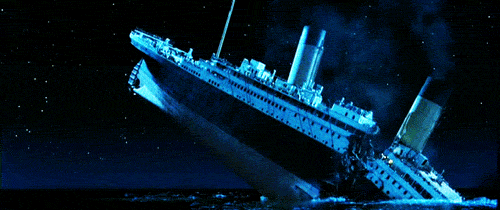In The Great Gatsby, F. Scott Fitzgerald emphasizes the
corruptions of the American Dream by conveying the consequences derived from
wealth. These consequences include the domination of wealth in the social
hierarchy and the lack of social mobility. Similar to The Great Gatsby, the movie Titanic illustrates the dangers that arise from a relationship between
an upper class female and a lower class male, in addition to revealing the true, depraved American Dream.

The Great Gatsby and Titanic illustrate the unevenness of power in the social hierarchy because of the upper class’s ascendency. In order to be highest in the social hierarchy, “holocausts” must be made (162). These sacrifices are evident in the Titanic through the discrimination between the first, second, and third class passengers. For example, the ship only had enough lifeboats for 1,178 people, but they were 2,223 passengers total. This unevenness resulted in sacrificing half of the passengers in order to save those in first class. In fact, over 55% of the Titanic survivors were first class passengers. Additionally, the Titanic’s layout positions the first class rooms on the higher floors and the lower classes on the bottom floors. As a result, the lower class floors were the first to flood after the wreck. Additionally, to decrease franticness, workers were commanded to lock the gates and trap the lower classes in their flooded floors. This confinement demonstrates the “holocausts” of lower classes in order to benefit those higher in the social hierarchy.
 In The Great Gatsby and Titanic
the wealthy female character develops a relationship with a poorer man and is
then faced to choose between him and a wealthier man. In The Great Gatsby,
Daisy fell in love with Gatsby, but he “let her believe that he was a
person from much the same stratum as herself” (149). This façade resulted in a
fallacious relationship. Additionally, Gatsby compared Daisy with a “grail” and
it “excited him, too, that many men had already loved Daisy – it increased her
value in his eyes” (149). Viewing Daisy as a price and judging her “value,” Gatsby
proves that he only loved Daisy because she was a part of his façade. However,
Daisy ultimately chose Tom over Gatsby because he was wealthier. Despite Tom’s
affairs, Daisy stayed with him because of their wealthy appearance. In Titanic, Rose was engaged to Cal because
her mother pressured Rose to marry him for his money. Despite Jack’s lower
class status, Rose chose him over Cal. After the shipwreck, Rose was sitting in
one of the last lifeboats, but jumped back onto the ship in order to be with
Jack. By returning to the sinking ship, Rose chose Jack over wealth and safety.
In The Great Gatsby and Titanic
the wealthy female character develops a relationship with a poorer man and is
then faced to choose between him and a wealthier man. In The Great Gatsby,
Daisy fell in love with Gatsby, but he “let her believe that he was a
person from much the same stratum as herself” (149). This façade resulted in a
fallacious relationship. Additionally, Gatsby compared Daisy with a “grail” and
it “excited him, too, that many men had already loved Daisy – it increased her
value in his eyes” (149). Viewing Daisy as a price and judging her “value,” Gatsby
proves that he only loved Daisy because she was a part of his façade. However,
Daisy ultimately chose Tom over Gatsby because he was wealthier. Despite Tom’s
affairs, Daisy stayed with him because of their wealthy appearance. In Titanic, Rose was engaged to Cal because
her mother pressured Rose to marry him for his money. Despite Jack’s lower
class status, Rose chose him over Cal. After the shipwreck, Rose was sitting in
one of the last lifeboats, but jumped back onto the ship in order to be with
Jack. By returning to the sinking ship, Rose chose Jack over wealth and safety.

This was a really interesting blog. There are some really good points about how the upper class is seen as more important than anyone else, I especially liked the chart showing the amount of people saved per class.
ReplyDelete